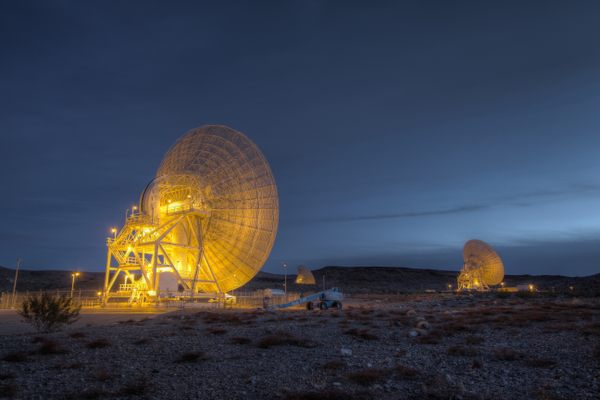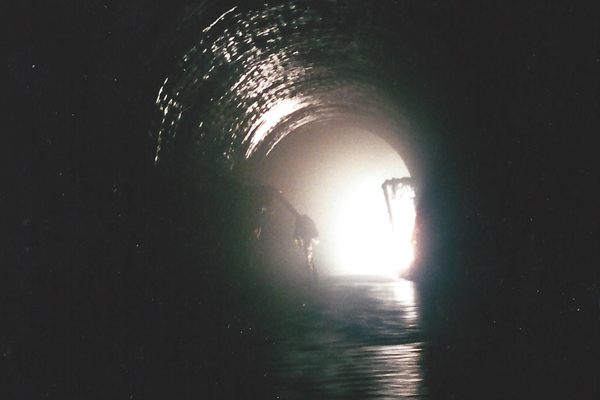Mars in the Mojave
Google Maps helped me locate the Goldstone 70 meter antenna in Mars, California, but it couldn’t help me get there. The Goldstone Deep Space Communications Complex (GDSCC) sits inside Fort Irwin, the U.S. Army’s National Training Center, which appears on the map as a vast, gray expanse in the Mojave Desert. Yet despite its air of mystery, it was quite easy to get directions to the complex by using the phone to call and schedule a tour. Hoping for a signal from the Red Planet, I set out to see NASA’s massive structures and to explore our own nearby martian landscape, Rainbow Basin.
The antennas at Goldstone communicate with spacecraft exploring planets, asteroids, and interstellar space. (Image via NASA)
Entering a high-security zone makes you feel a bit like a secret agent. Driving alongside tanks and men in uniform, I passed through two checkpoints requiring license, vehicle registration, and proof of insurance. Foreigners receive special badges (perhaps in case they’re spies?). Pets, weapons, and alcohol are forbidden. Finally, after gaining clearance and receiving safety instructions, we began our three-hour tour.
Storms behind the Echo-DSS 12 antenna and Goldstone Museum. Photo by the author.
The dishes of GDSCC communicate with various spacecraft, including the “most distant human-made object in existence,” Voyager 1, currently traveling over 11 billion miles away from the Earth in interstellar space. These super-sensitive antennas can receive signals as weak as a single attowatt.
GDSCC is one of three complexes that make up NASA’s Deep Space Network. Located at equidistant positions across the world, this network allows constant communication with spacecraft as the Earth rotates. The other two complexes are in Madrid, Spain, and Canberra, Australia. Each is set inside a geographic depression, sheltered from interfering radio signals.
The lonely landscape was rumored to be inhabited by burros, desert tortoise, cougars, and rattlesnakes. Photo by the author.
Our caravan made several stops within the 53-square-mile complex, including the museum, the Signal Processing Center, the Apollo Station, the Beam Waveguide Cluster, and finally, the Mars Station, the largest antenna at GDSCC. Standing 24 stories high, the Mars Station’s large parabolic dish measures 70 meters in diameter; too large to fit in the frame of my camera. It communicates with many spacecraft, including the Curiosity Rover on Mars.
The Mars Station received astronaut Neil Armstrong’s famous quote:“That’s one small step for a man. One giant leap for mankind.” Photo by the author.
To my great disappointment, no secrets of extraterrestrial intelligence were revealed. But the evidence of human intelligence was astonishing. Standing beneath the looming dish of the Mars Station, I was reminded of how recently the Space Age began. Today, technology continues to push forward at lightning speed. In fact, the non-profit Mars One Foundation plans to send a manned crew to settle on Mars by 2024. Last fall, their call for astronauts resulted in over 200,000 applications. Would you volunteer for a one-way trip Mars?
Curiosity’s tracks on Mars. (Image via NASA)
Rainbow Basin Natural Area, Barstow, California. Photo by the author.
Since I was resolved to my earthbound status, I traveled 30 miles south to the Rainbow Basin, where lack of precipitation and extreme temperatures have created a fantasy landscape that’s as inhospitable as the mountains of Mars. In fact, this geological wonder is so barren and isolated that the US Bureau of Land Management recommends telling a friend or family member where you are going and when to expect you back, just in case someone needs to look for your body.
Loop Road. Photo by the author.
Rainbow Basin can be explored in an hour or several days. If you’re in a hurry, try Loop Road, a scenic ride that feels more like Disneyland than a National Landmark. Four wheel drive and high clearance are highly recommended for this narrow, roller coaster path. If you have more time, stay at Owl Canyon campground, and get lost in the dry riverbeds and canyons. Just remember to bring enough water and proper supplies. It’s not Mars, but you will certainly feel like the last person on Earth.
Colored rock layers. Photo by the author.
Hiking along a dry riverbed. Photo by the author.
A yellow wild flower known as the prince’s plume. Photo by the author.




















Follow us on Twitter to get the latest on the world's hidden wonders.
Like us on Facebook to get the latest on the world's hidden wonders.
Follow us on Twitter Like us on Facebook